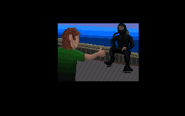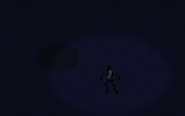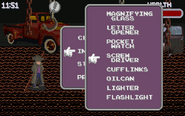Last week, I finished playing an SNES title called "Conplus." It had been frustrating me since childhood, and it was an unusual game for several reasons. First, with a copyright date of 1998, it was one of the last games released for the console. More noticeably, there was a tiny glass bubble on the front of the cartridge that made it stand out from the other games in my collection. Last, and most importantly, the game had literally no online presence. No fansites, no ROMs, not even a mention. The company that made it, Infinite Cycle Ltd, was a complete nonentity too. Left with no other options, my only hope to find out anything was to, as the game described it, "complete six challenges."
Conplus was a sort of "variety pack," a dozen small games on a single cartridge. Similar to Action 52, except competently programmed. Each game had a "challenge" to complete, generally something like reaching the end, getting a certain score, or surviving for a certain length of time. It varied by game, and you were never told what the challenge was until you'd beaten it. Here are the six that I was able to do. Chapter 1: "'Dino Run"' In this game, you control a young dinosaur and guide it through a maze in an isometric view. Food is scattered across the maze, and you complete a level by eating all of it before hitting the time limit. To get through the maze, you have to navigate through obstacles and hazards such as hostile creatures, pits, jets of flame, one-way doors, and deep water. The graphical style is very "cute," reminiscent of Bubble Bobble or the Kirby series. Dino Run has a two-player mode where you try to eat more food than the other player. Me and my friends killed a lot of time on this one when we were young, charging madly through and trying to bait each other into traps.
The challenge for this game was to complete one hundred levels. There was no save option, and the later mazes were extremely unforgiving, but you could restart from your current level no matter how many times you died. Even setting aside a lot of time in the evening to play it, I had to leave the game running and paused for several nights before I got to the end.
Chapter 2: Alchemy Lab
A puzzle game in the vein of Tetris or Dr. Mario. Gears with three teeth fall from the top of the screen, and each tooth has a colored gem. Once a gear lands, it can be rotated, and you clear gears from the screen by having three gems of the same color touch each other to score points. You lose if the gears overflow the top of the screen. This game also supports competitive multiplayer, in which you and another player can interfere with each other by scoring large combos to send useless and difficult-to-remove "rusty gears" down to each other's playfield.
The challenge on this one was to complete the "story" mode, which pitted you against a series of eight AI opponents, on the hardest difficulty. I loved this game as a kid, and its challenge was the only one I'd completed when I was younger.
Chapter 3: East vs. West
A turn-based wargame based on the Cold War, circa 1970. The player could choose to play either NATO or the Warsaw Pact in a fight for control of the entire world. No nuclear weapons are allowed (or even mentioned), but aside from that it's fairly realistic, with the player needing to keep units supplied with fuel, food, and ammunition, bad weather hampering operations, radar and scouts needed to spot the enemy, etc. Like the last two games, it has a two-player mode, but the whole thing is so heavily balanced in the Pact's favor that you can't really have a fair match. Maybe Infinite Cycle was staffed by bitter Russians.
After losing as NATO over and over, I eventually gave in and won as the Pact, which still counted. It kind of defeats the point of being a challenge if you can just cheese your way through it, doesn't it? That said, it still took me a ridiculously long time to complete — 200 turns or so, in fact, most of which was spent throwing waves of troops across the Bering Strait. Luckily, this game had a save function.
Chapter 4: Stalker
A 2D side-scrolling horror/adventure game. Your character is a man clad in a fedora and trench coat, trapped in a desolate building and pursued by a thematically fitting humanoid figure. For example, the first level is a medieval castle, and your attacker is an animated suit of armor; the second is a workshop with a knife-wielding wooden dummy. In each level, your goal is to find a way to destroy the stalker. In the meantime, you have to plan your movements to avoid it and run or hide if it finds you. Based on the man's attire and the style of the cars in the abandoned factory level, I'd say the game probably takes place in the early 20th century.
I didn't play this one much as a kid because it scared me and I couldn't figure out how to progress. I completed the challenge for this one by finishing all four levels. Some of the puzzles were pretty obtuse (I have yet to figure out how "in memoriam, awaken the seer" translates to "set the pocket watch to eight o'clock and put it in the fruit bowl"), and I had to brute force a fair amount of them, just using every item in my inventory on everything that could be interacted with until I found something that worked. I was glad to be done with this one.
Chapter 5: Into the Silent Forest
This one puts you in the role of a young boy and dumps you in a cabin at the edge of a forest without an introduction or title screen. You wander around the map in a top-down view, making your way through a winding, twisting maze of trees. And that's it; the game never gives you any hint of who your character is supposed to be or what they're trying to accomplish, and I didn't notice any enemies or hazards the entire time I played. The only possible threat I might have seen, and I can't swear to this, is an occasional glimpse of some emaciated, skull-faced creature standing hunched over in one of the trees.
Graphically, it's just as weird; the sprites look like something you'd see on the NES, and the ground is a solid black. There's no music, either. It makes me think it was probably some alpha build that, for some reason, made it into the cartridge alongside a bunch of finished games.
My initial assumption was that I had to make it out of the forest. This was after a few hours of walking everywhere, bumping into anything that looked remotely interesting and pressing every button in the hopes that something would happen, occasionally setting the controller down to sketch out a map in my notebook. There were several locations that looked like they should have been important, but weren't. Among these were a wide ring of stakes surrounding a small pile of burnt wood, an abandoned tent containing a rifle and axe, and a gravestone on top of a steep, rocky hill. While none of these had any apparent ingame purpose, they were at least useful as landmarks.
I finally completed the challenge for this one by finding a well and jumping into it. I don't know why that worked, but it did, and kind of sums up why I gave up on this game pretty quickly as a kid.
Chapter 6: Dark Waters
The last game I completed, and one that scared me badly enough as a kid that I'd only played it once. This one opens with a cutscene showing an overhead view of a motorboat moving to the middle of a small, vibrant blue lake on top of a tall mountain. Then it switches to a close-up view of the boat, which has one man at the engine and another man in scuba gear sitting at the edge. The man at the engine gives the diver a thumbs-up, and the diver drops off the side with a splash.
The game itself is simple. You are deep within the lake — so deep that all you can see (aside from your character) is darkness. You view the diver from behind as he swims forward, and you can move him left, down, up, and right as he goes. For about a minute, nothing happens. All there is to do is listen to the music, an uneven drumbeat with a pitch almost too low to hear.
That's when you see the shadow in the distance, which very quickly grows into a roaring mouth full of razor-sharp teeth that takes up about half the screen.
And that's Dark Waters. Sit there, wait for one of those creatures to show up, and as soon as you can see which part of the screen it's coming from, try to pull off a split-second dodge. If any of them touch you, you die. Even after the first, they still come infrequently, but gradually the time between attacks drops until you're constantly dodging them. Worse, you can't pause the game (which, incidentally, means you can't go back to the main menu). You either sit there and do it perfectly for however long it takes, or you have to start all over.
I completed the challenge on this one by surviving for one hour, but it felt like a lot longer than that. I was actually shaking by the end of it, hissing a choice swear word every time one of the monsters came too close for comfort.
Once I finished the challenge for Dark Waters, the game showed a congratulatory message against a starry night background. Colorful, pixelated fireworks flashed and popped across the screen, and I sat there to admire them for a moment before I read the line of orange text at the bottom.
"PRESS START TO RECEIVE YOUR REWARD"
I did so, but I wasn't prepared for what I saw next.
It was an image of me, in my bedroom when I was younger, rendered in the best detail an SNES was capable of. My younger self sporting a goofy grin, sitting on a tan-carpeted floor and back against a bed, holding a controller while sunlight bled around a shadow in the curtains. Judging by how young I looked in the picture, it was quite possible it was from one of the first times (if not the first time) I'd ever played the game, and judging by the angle, it looked like the picture had been taken from the console itself.
I'll admit, I jumped when I realized what I was looking at. Once I'd calmed down, I scooted over to my entertainment center and looked over the console. Then my eye was drawn to the strange glass bubble in the cartridge, and it all made sense.
That was the camera. The manufacturer had put it in there, it took a picture at some point while I was playing, and saved it to show it to me when I earned the right to see it. It made sense. If they could put a camera in a Game Boy cartridge, why not in a Super Nintendo one?
I laughed. It was a neat idea. Getting back to where I'd been sitting, I took one last chance to marvel at the bit of technical wizardry, but when I did, that was the moment I decided I never wanted anything to do with this game again.
You see, what I'd taken to be a shadow on one of the curtains wasn't really a shadow at all. It was the outline of an emaciated, skull-faced creature.
StarmanGhost (talk) 03:54, November 27, 2014 (UTC)
Author's note: I also posted this story to Slimebeast under the handle "Dr. Killjoy." If you want to verify that I'm the author of this story, you can check my note at the bottom of my post here.
Image Mock Up Gallery by Urkel
----



















